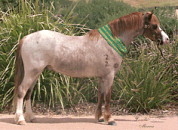
COMMON HORSE BREEDS
| ROAN HORSE & PONY
Origin: |
 Photo supplied by the Roan Horse & Pony Society Of Australia Inc © |
History:
The term Roan does not refer to a specific breed of horses but to a type of colour. The origin of the Roan is not clear but can be found all over the world. In Australia Roan is most commonly found in Quarter Horses & Welsh Ponies and the breeds derived from these, Australian Stock Horse, Australian Pony, Arabian Pony, Quarab & Riding Pony, with some Shetlands and Miniature Ponies & Horses. In May 2009 The Roan Horse & Pony Society of Australia Inc was established as a non-profit organisation for the promotion and registration of horses and ponies which are genetic roans and as a means to educate people as to their charactistics and genetics.
Characteristics:
Height: Roans occur from miniature to full sized horses
Conformation: Variable
Colour: The base colour includes all colours known in the equine world with the roan coat pattern present & must meet Society colour guidelines
compact, muscular horse
Colours
ROAN is a dominant allele which modifies the coat colour by 'roaning' the body but leaving the head and legs the solid base colour. When branded or blemished the brand or blemish will grow back in the same solid colour as the head. A characteristic of roans is the spearing of the points on the front legs, in a non-roan the points end in the horizontal plane while in a roan they spear upward into the forearm. Often this spearing of the points is the only way to distinguish a palomino or buckskin roan.
For many years it was believed that roan was lethal in the homozygous state i.e. if two roans were bred together that there was a 25% chance of a non-viable embryo which would be aborted. This has been disproved and genetic homozygous roans have been confirmed in USA.
Colour requirements
Roan will work over every colour, the darker the base colour is the more distinct the contrast. Palomino & buckskin roans can be very hard to distinguish. Cremello or perlino roans cannot be determined on visual inspection, only by DNA zygosity testing or by the progeny they produce.
A grey horse can carry the roan allele and produce roan foals if it was born roan itself. While a grey horse becomes progressively lighter with age, eventually ending up white, a roan horse is obviously roan at first coat change as a foal and will remain that colour forever. The body coat colour will lighten and darken according to the time of year but the head and points remain the base colour. Many horses which are turning grey are incorrectly termed roan as are many that are merely heavily ticked.
A DNA roan zygosity test has now been developed in USA which will make determination of dilute and double dilute roans a much easier task. This test was developed on Quarter Horses and Paints but has now been proven to work on Welsh, Ponies, Partbred Arabians, Riding Ponies & Australian Ponies so the test is now available at a low cost commercially.
For further information see //www.vgl.ucdavis.edu/services/Roan.php and //www.vgl.ucdavis.edu/services/horse.php
Today:
Roans are good all-round versatile riding horses & ponies which are used for pleasure, performance, farm work, show ring & childrens mounts.
![]()